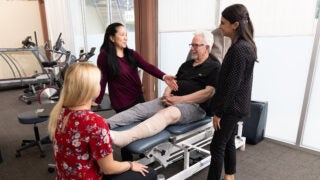Keck Medicine of USC research links tobacco smoke and roadway air pollution with childhood obesity
FOR IMMEDIATE RELEASE
9 a.m. EDT (EST) / 6 a.m. PDT (PST)
Wednesday, Nov. 12, 2014
Contact: Leslie Ridgeway at (323) 442-2823 or lridgewa@usc.edu
For a copy of the study, contact Leslie Ridgeway.
LOS ANGELES — New research from Keck Medicine of the University of Southern California (USC) bolsters evidence that exposure to tobacco smoke and near-roadway air pollution contribute to the development of obesity.
The study, to be posted online Wednesday, Nov. 12, 2014 in Environmental Health Perspectives, shows increased weight gain during adolescence in children exposed to secondhand tobacco smoke or near-roadway air pollution, compared to children with no exposure to either of these air pollutants. The study is one of the first to look at the combined effects on body mass index of exposure to both near-roadway air pollution and tobacco smoke. The effects were substantially greater in children exposed to both air pollutant mixtures than to either alone.
“Vehicle miles traveled, exposure to some components of the near-roadway air pollutant mixture, and near roadway residential development have increased across the United States over the last several decades corresponding to the epidemic of childhood obesity,” said Rob McConnell, M.D., professor of preventive medicine, Keck School of Medicine of USC and lead author on the study. “The potential for near-roadway air pollution to be among several factors contributing to the epidemic of obesity merits further investigation.”
The research builds on previous studies showing that exposure to secondhand smoke and particulate air pollution cause heart and lung disease.
Childhood obesity has doubled in children and quadrupled in adolescents in the past 30 years, according to the Centers for Disease Control and Prevention (CDC). Obese youth are more likely to suffer from health challenges, including high cholesterol, high blood pressure, diabetes, bone and joint problems, social stigmatization and self-esteem problems. Obesity for children is defined by the CDC as a BMI at or above the 95th percentile for children of the same age and sex.
The USC study examined exposure of more than 3,000 children to tobacco smoke during their mothers’ pregnancy and to secondhand smoke, as well as air pollution effects from busy roadways, and looked for associations with body mass index. The children were enrolled at age 10 in the Southern California Children’s Health Study, started in 1992 to study the long-term effects of air pollution on children. The children were followed yearly over an eight-year period through high school graduation at age 18. Most of the children were non-Hispanic white or Hispanic.
The researchers estimated near-roadway pollution exposure, taking into account traffic volume, how close the children lived to roadways and predominant wind direction. At study entry, a parent-completed questionnaire was used to determine lifetime tobacco smoke exposure.
“Further research is needed to determine if our findings can be replicated in other populations,” McConnell said, “and to assess both the potential contribution of combustion sources to the epidemic of obesity and the potential impact of interventions to reduce exposure.”
Funding for the research comes from the National Institutes of Health (grants P01ES022845, P30ES007048, P01ES009581, P01ES011627, P50 CA180905, R01ES016535, R01HD061968 and R03ES014046), the Environmental Protection Agency (grants RD83544101, R826708 and RD831861) and the Hastings Foundation.
###
McConnell, R., Shen, E., Gilliland, F.D., Jerrett, M., Wolch, J., Chang, C., Lurmann, F., Berhane, K. (2014). A Longitudinal Cohort Study of Body Mass Index and Childhood Exposure to Secondhand Tobacco Smoke and Air Pollution: The Southern California Children’s Health Study. Environmental Health Perspectives. Published online Nov. 12, 2014.
###
ABOUT KECK MEDICINE OF USC
Keck Medicine of USC is the University of Southern California’s medical enterprise, one of only two university-based medical systems in the Los Angeles area. Encompassing academic, research and clinical excellence, the medical system attracts internationally renowned experts who teach and practice at the Keck School of Medicine of USC, the region’s first medical school; includes the renowned USC Norris Comprehensive Cancer Center, one of the first comprehensive cancer centers established by the National Institutes of Health (NIH) in the United States; has a medical faculty practice, the USC Care Medical Group; operates the Keck Medical Center of USC, which includes two acute care hospitals: 401-licensed bed Keck Hospital of USC and 60-licensed bed USC Norris Cancer Hospital; and owns USC Verdugo Hills Hospital, a 158-licensed bed community hospital. It also includes more than 40 outpatient facilities, some at affiliated hospitals, in Los Angeles, Orange, Kern, Tulare and Ventura counties.
U.S. News & World Report ranked Keck Medical Center of USC among the Top 10 in ophthalmology (No. 9), and among the Top 25 hospitals in the United States for urology (No. 20) and cancer care (No. 23). The medical center was also awarded an “A” grade from The Leapfrog Group in March, representing outstanding patient safety practices and overall patient outcomes.
For more information, go to www.keckmedicine.org/beyond.


